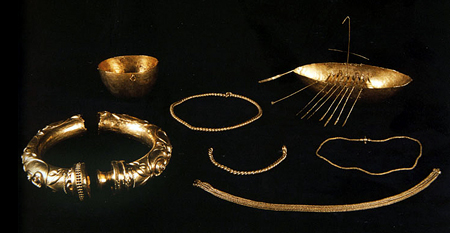
The remarkable Broighter hoard, arguably the finest treasure trove of the Irish Iron Age, was discovered on a February evening in 1896 by two Derry men, Thomas Nicholl and James Morrow. They had been ploughing a stubble field adjacent to the shoreline of Lough Foyle when they suddenly hit something hard. On investigation they discovered a number of metal items ‘arranged inside one another’ (O’Neill 1993, p. 24). Curious to see what these dirt encrusted objects were they brought them home where they were washed over an open sink by the future Mrs. Nicholl (she was then the maid). Unaware that that the dirty objects were made of gold she later admitted that it was possible that some smaller pieces may have washed down the drain! Interestingly she also said that the artefacts appeared to be coated in ‘some greasy material’ (ibid) and this could indicate that they were originally deposited in an organic container, possibly a bag.
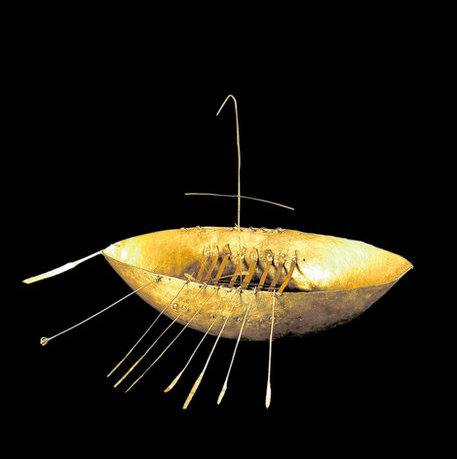
It soon became clear that these initially innocuous looking objects actually represented a gold hoard of stunning quality. In total it contained a model boat, two twisted bar torcs, two necklaces, a beaten bowl and an elaborately decorated buffer torc. The most remarkable piece is probably the small boat. This is a unique find in an Irish context and represents the earliest depiction of a sailing ship from Ireland. Finely crafted, it measures 18.4 cm long by 3 7.6 cm wide and weighs approximately 85g. The vessel contains benches, rowlocks, two rows of nine oars and a paddle rudder for steering. It also included tools for grappling, three forks, a yardarm and a spear. If it is to scale the model boat would mimic a vessel that measured approximately 15m in length.
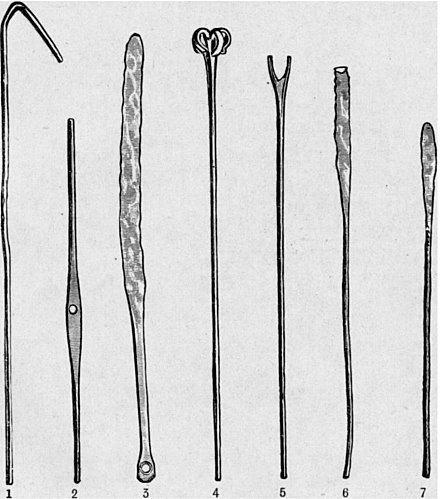
The other artefacts from the hoard include a small bowl made from beaten gold that has four rings for suspension . It is likely that this represents a cauldron, an object that could have ritual significance as well as a purely functional use during the Iron Age. The wire necklaces are imports from the Roman world, most likely the Mediterranean region and date from circa the 1st century BC to 3rd century AD. The twisted torcs, although probably of Irish origin are very similar to neck ornaments found in Britain during the 1st century BC. The final artefact, the buffer torc, is a magnificent object and has been described as a masterpiece of artwork in the La Téne style (Waddell 1998, 294). It consists of a hollow tubular neck-ring of hammered sheet gold, with separate buffer terminals held in place with gold pins (ibid).
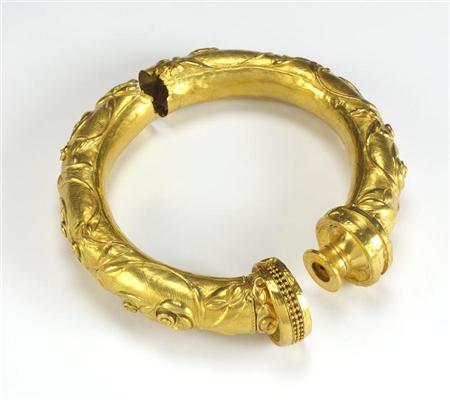
A small number of similar type torcs are known from the continent during the 1st century BC. However, the rich decoration which covers the Broighter neck-ring is of insular Irish style suggesting that it was manufactured locally, possibly by a skilled craftsman with contacts with Britain and beyond. The motifs used on the torc appear to represent stylised birds or horses, while Richard Warner (Ulster Museum) has suggested that some of them may depict sea-horses.
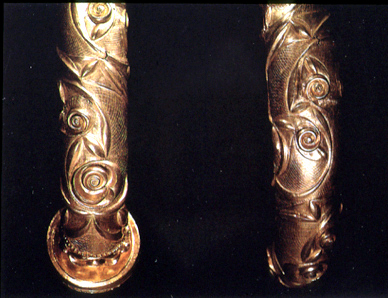
The nautical nature of some of the finds from the hoard and its location beside the sea, in an area that may have been submerged in antiquity, has led to some speculation that it represents a votive offering to an underwater deity, possibly Manannán mac Lir. In legend this ancient Irish sea god is associated with Lough Foyle, a large cauldron, sailing ships and a magical horse capable of journeying over land and sea (after Waddell 1998). Is it possible that 2,000 years ago an Irish king placed a bag of golden offerings to appease this ancient sea deity?
by Colm Moriarty
References
O’Neill, K. 1993. ‘The Broighter Hoard, or how Carson caught the boat’. Archaeology Ireland Vol. 7, No. 2, pp. 24-26
Waddell, J. 1998. The Prehistoric Archaeology of Ireland, Wordwell, Dublin.



Wonderful, glorious, stunning …. sorry, I’ll stop now. But the Broighter Boat is a central image from my childhood, when my father worked in the National Museum, and the hold it took on imagination is one of the reasons I’m a writer today. Loved reading this piece.
How can I move the share bar? It gets in the way of reading and I end up giving up
Hi Barbara,
Sorry about that, I wasn’t aware the sharing widget was causing a problem. It looks ok on my laptop. Are you using a mobile device? I’ll turn if off anyway, I don’t want people not being able to read the articles :).
All the best,
Colm.
Thanks. It’s ok on my PC but not on my netbook. If there was a way of dragging it out of the way it’d be no problem
What a glorious reminder of a culture that was so marginalized by the records left by the Romans. The remnants both linguistic and material are a tantilizig glimpse into a cultural complex which from the Late Neolithic on was as important in its own right as those of the Mediterranean an East.
The story behind the find doesn’t stop their with my Great Grandfather Thomas Nicholl who found the Hoard had to go to London in a long running Court Case. A funny story of them having to employ someone to translate Toms Limavady accent that the British Court Officals found hard to understand. My Great Grandfather used the expenses he received from his trip to London to pay for his marriage to Maggie (the maid that helped him wash the gold artefacts after the find).